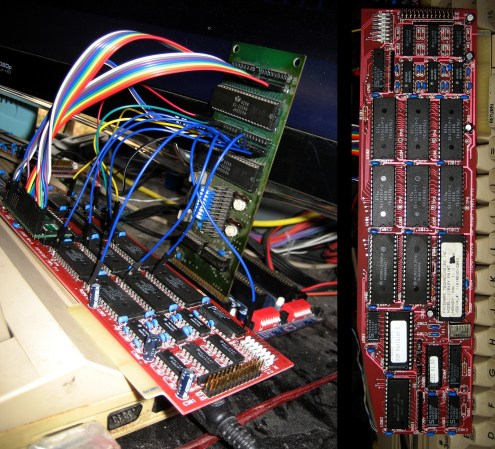
Need to share a printer between several Apple II computers? Of course you don’t, but back in the day this would have been a really awesome piece of hardware to own. It’s a Pacemark iiEasy Print (we’re not sure on the capitalization of the name so talk amongst yourselves). It is an automatic buffer and switch that you can have now-a-days for just a couple of Hamiltons. [David] doesn’t mention where he “acquired” his specimen, but all the details about his adventures reverse engineering the card are shared in detail.
First off, we have to mention his unorthodox bench tools. To the untrained eye it would appear that he has attached the iiEasy Print to a Commodore 64; and that eye would be right. [David] says he uses the C64 something like an Arduino (if that’s even possible). The green card is plugged into the C64 memory bus, connecting to the DIP socket breakout board on the left and the chip select pins for most of the other IC’s on the original board. The gist of this setup is that it’s simple to use the “passthrough” DIP socket to monitor what the 6502-like processor is doing, while mapping the memory with the help of the chip select signals.
What did he learn from all this? Quite a lot but you might as well click that link above and hear it from his own mouth.














might be missing the article title >_>;
Yep, title is missing and it’s messing up the RSS name :)
Holy Hardward’s, Batman!
Hardward is different from, but similar to Softward. Think of hardwood v. softwood. Just as some “softwoods” are harder than some “hardwoods”, some Softward is warder than Hardward, but don’t confuse the two with Firmward, it takes a programming genius, knowledgeable in Hardward and Softward to properly wardify Firmward.
Where does BurtWard fit in to all of this?
BurtWard is who you see before waking up in the BurnWard when things go terribly wrong when working with HardWards or FirmWards. Sticking to SoftWards is usually safer, but less ReWarding.
It’s actually the Commodore 64C, a somewhat upgraded, but still functionally identical, version of the original one.
@szczys, Article title matching the WP post would be fine. :)
I don’t make the best writer of course, so it’s somewhat unclear: This card is actually a standalone 6502-based system with six serial ports. Perfect for the tinker in all of us. Now and then they appear on Ebay, and I was lucky enough to score more than one.
David, that’s some pretty awesome reverse engineering! I’m really impressed.
Would you like some more Apple 2 cards to add to your collection? I’ve got several that have been collecting dust for the last 20-some years. I know there’s a 1 Mbyte battery-backed RAM disk in there. I recall there’s also a sound card and 3 MHz speedup card.
Contact me and I’ll send you this old stuff, absolutely free. My contact info is on my website.
@Paul, Now i’m not sure which is more awesome, the hack itself, or people like you.
“[David] says he uses the C64 something like an Arduino (if that’s even possible).”
I think I read somewhere people used the sound chip for pwm signals. I don’t know I haven’t touched a c64 in so many years but I am glad to see people still use them.
Tough to “embed” a C64. You get more power and better interface capability with a Maximite with a similar retro-80s feel. A better BASIC with built-in routines for CAN, serial, I2C, SPI, PWM, etc…
@Gizmos- Thanks for the note about the Maximite, I’ll have to check it out. :)
I used my C-64 since it’s always on my desk and I’ve been wanting to find an excuse to use the GPIO card. ;)
Very interesting read. Nice to see the BASIC code driving your GPIO card as well. (Except, I’ll have to stare at it for much longer to make sense of how it works.)
Thanks. :) It’ll help if you have the 6522 VIA datasheet on hand while reading the program. Google will be your friend there, as there’s still a company making a pin compatible IC.
Amazing! Colossal! Or whatever B. Baggins said… But seriously that’s an amazing job of reverse engineering that board. As it happens I’m largely self taught 6502 assembler and our old friend BASIC.
Something else, does anyone remember to spell check the headlines for these articles? That word is “hardware” not the made up one shown.
I kept trying to say something about that but HaD keeps failing to get my g+ login
ohh C64 and BASIC
10 PRINT “HOW COOL IS THAT?”
20 GOTO 10